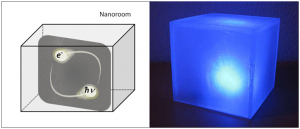Phtons and electrons talk to each other at the nanoscale
- A technological solution to control the transmission of information between electrons and photons at the nanoscale by means of electrical currents is proposed in the framework of an international collaboration of our group.
- The conceptual proposal, published in “Science Advances”, is based on the exploitation of the quantum tunneling regime of transport of electrons in a cavity and couple it to the light “trapped” in the same cavity, thus creating a common space of dialogue where the exchange of information is faster and more efficient.
The exchange of information carried by photons of light and electrons in miniaturized electronic devices is a longstanding technological challenge that might be now closer to a solution thanks to the proposal by a team of researchers in an international collaboration at our Center for Materials Physics (CSIC-UPV/EHU) and DIPC in San Sebastian (Spain), the Institute of Molecular Sciences in Orsay (France), the University of Los Andes (Colombia),and the Nanophotonics Laboratory in Houston (USA).
We all have sometimes felt a certain frustration when trying to communicate with another person who speaks a different language. This situation also occurs between photons of light and electrons in electronic devices. They speak “different languages”, even though it is highly desirable that they manage to understand each other. Light is a fast and reliable means of delivery information which is currently used in modern communications, however, most of this photonic information has to be processed and dealt with by electrons in miniaturized electronic devices, such as in state-of-the-art transistors. Due to the mismatch of dimensions and speed of one (photon) and another (electron), a problem arises when transferring information from the photons of light to the electrons in electronic devices, and vice versa. The electrical fields associated with a photon oscillate very fast in time (of the order of 1015 times per second) and spread in space due to the diffraction limit, whereas electrons typically move driven by constant, static fields in much more reduced dimensions of a few nanometers. This impossibility for electrons and photons to talk to each other in reduced dimensions is a current technological bottle neck.
Now, our international research team makes a conceptual proposal, published in Science Advances, where the quantum tunneling regime in a metallic nanogap, which can be seen as a metallic “nanoroom”, is predicted to serve as a matching environment to facilitate the dialogue between photons and electrons, exchanging information in a fast and effective way. In this miniaturized “nanoroom”, on the one hand, photons are squeezed down to the same nanoscale dimensions as those typical of electrons thanks to a material excitation so-called plasmon. Plasmons help to “trap” light in this “reduced room”. On the other hand, the excitation of this “trapped light” is found to depend on the actual DC (static) current driven between the two electrodes of the “nanogap room”, thanks to the tunneling of electrons between one wall of the room and the other wall. In more plain words: “It is like using a very tiny room where we trap together electrons and photons, and the photons shine or quench depending on how the electrons bounce forth and back on the room’s walls”.
Controlling the activation or deactivation of the fast oscillations of light with static currents at this miniaturized level can be only possible due to the exquisite dependence of the trapped light to the tunneling regime of electrons across the nanogap. For the first time, the team of researchers led by Andrei Borissov in Paris and Javier Aizpurua in San Sebastián, propose a technological solution to create an electrooptical modulator at the nanoscale. The principle of action requires very precise fabrication of nanoscale gaps, where light can get trapped, as well as a convenient and simultaneous bias applied between these electrodes to control the DC tunneling current. Only under these conditions, electrooptical modulation at the nanoscale is possible.
The level of modulation can be optimized in future nanodevices, but this electrooptical concept at the nanoscale opens a door to the development of new technologies of information, where electrons and photons can talk to each other faster and in a more compact manner, thus with less consumption of energy per bit of information exchanged.
Figure: Schematics of a figurative nanoroom where photons (ħn) and electrons (e–) are trapped establishing a dialogue to transfer information. The nanoroom is a plasmonic nanocavity and the electrons bounce forth and back in the cavity thanks to the electron tunneling regime, controlling the intensity of the “trapped” photons.
Publication: Active quantum plasmonics.
D. C. Marinica, M. Zapata, P. Nordlander, A. K. Kazansky, P. M. Echenique, J. Aizpurua, and A. G. Borisov.
Science Advances 1, e1501095 (2015)
DOI: http://dx.doi.org/10.1126/sciadv.1501095


